
John Lawrence LeConte was an American entomologist, responsible for naming and describing approximately half of the insect taxa known in the United States during his lifetime, including some 5,000 species of beetles. He was recognized as the foremost authority on North American beetles during his career, and has been described as "the father of American beetle study".

Cleroidea is a small superfamily of beetles containing over 10,000 species. Most of the members of the group are somewhat slender, often with fairly soft, flexible elytra, and typically hairy or scaly.

Zopheridae is a family of beetles belonging to Tenebrionoidea. It has grown considerably in recent years as the members of two other families have been included within its circumscription; these former families are the Monommatidae and the Colydiidae, which are now both included in the Zopheridae as subfamilies or even as tribe of subfamily Zopherinae. Some authors accept up to six subfamilies here, while others merge all except the Colydiinae into the Zopherinae.
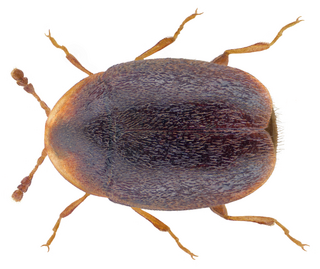
Corylophidae is a family of minute hooded beetles, sometimes called minute fungus beetles, in the superfamily Coccinelloidea. There are about 18 genera and at least 120 described species in Corylophidae. They feed on microfungi such as molds, and are often found associated with bark, as well as in leaf litter and other decaying vegetation. In older literature, the family name was often given as Orthoperidae.

Dorcatominae is a subfamily of death-watch and spider beetles in the family Ptinidae. There are about 16 genera and at least 190 described species in Dorcatominae.

Hydrochus is the only living genus of beetle in the family Hydrochidae, which belongs to the superfamily Hydrophiloidea. Hydrochus includes about 180 species, which are found worldwide. Hydrochus has also been used for a fly genus in the family Dolichopodidae. This junior homonym is a junior subjective synonym of the genus Rhaphium.

Melandryidae is a family of beetles in the superfamily Tenebrionoidea. Members of the family are found worldwide, with around 420 species in 60 genera. Larvae and adults are generally associated with rotting wood and wood-decomposing fungi.
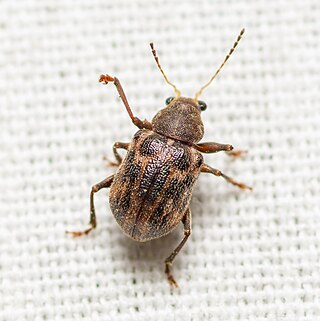
Xanthonia is a genus of leaf beetles in the subfamily Eumolpinae. It is distributed in North and Central America, and in East, Southeast and South Asia.

The Brachypsectridae are a family of beetles commonly known as the Texas beetles. There are only two extant genera, Brachypsectra and Asiopsectra. Brachypsectra has a cosmopolitan distribution, mostly in arid regions, while Asiopsectra is found in Central Asia and the Middle East.

Scaphinotus is a genus of beetles in the family Carabidae. There are at least 60 species, all native to North America. They eat snails and are generally limited to the moist environments where snails live. These beetles are flightless.

Berosus is a genus of beetles in the family Hydrophilidae, the water scavenger beetles. The genus contains 273 species. It is distributed worldwide.
Berosus aculeatus is a species of hydrophilid beetle native to the United States and Cuba. It was originally described by John Lawrence LeConte in 1855 and is characterized by prolonged apices of its elytra.
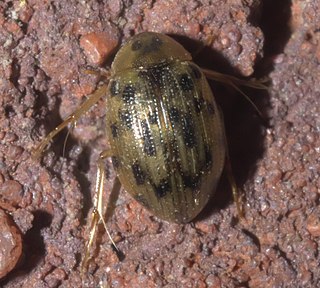
Berosus pantherinus is a species of hydrophilid beetle native to the United States. It was originally described by John Lawrence LeConte in 1855 and is characterized by having ten dark spots on each elytron.
Berosus ordinatus is a species of hydrophilid beetles native to the United States, specifically in the states of Maryland, Delaware, New York, New Jersey, Pennsylvania, Connecticut, and Rhode Island. It was originally described by John Lawrence LeConte in 1855 and is characterized by slightly divergent and prolonged elytral apices.
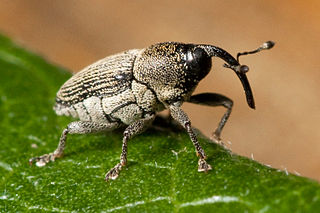
Apostasimerini is a tribe of flower weevils in the family of beetles known as Curculionidae. There are over 240 genera and nearly 1700 described species in Apostasimerini.

Clypastraea is a genus of minute hooded beetles in the family Corylophidae. There are more than 20 described species in Clypastraea.

Pycnomerus is a genus of ironclad beetles in the family Zopheridae. There are more than 20 described species in Pycnomerus.
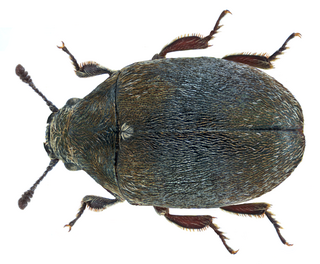
Morychus is a genus of pill beetles in the family Byrrhidae. There are at least three described species in Morychus.
Nematidium is a genus of cylindrical bark beetles in the family Zopheridae. There are at least three described species in Nematidium.
Rhadine caudata is a species of beetle native to the eastern United States. It is a brachypterous habitat specialist, occurring in only two of five forest classes in a North Carolina study. R. caudata is a considered a Vulnerable species at the global level on NatureServe, Imperiled in Alabama, and Vulnerable in Virginia.















